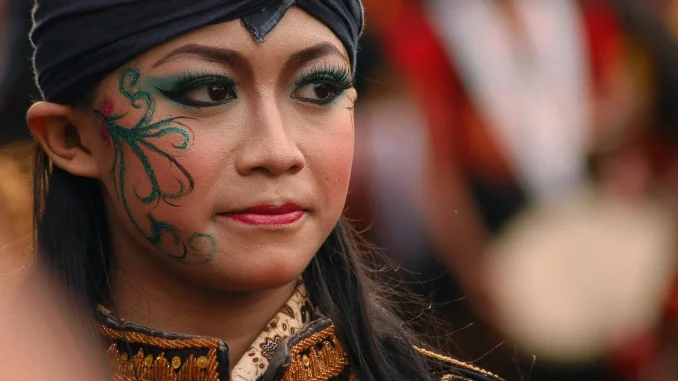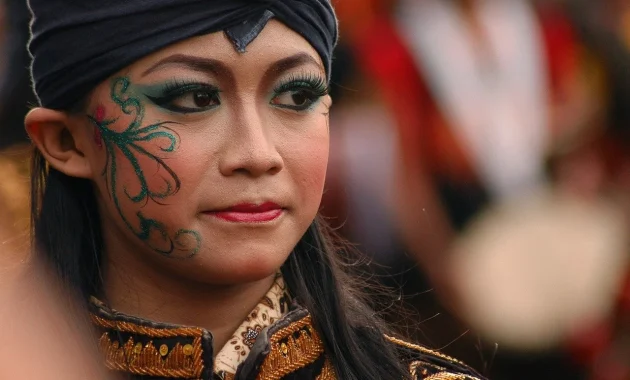
Indonesia is a vast archipelago that stretches across Southeast Asia, boasting a unique blend of cultures, traditions, and languages. With over 17,000 islands and more than 300 ethnic groups, the country is one of the most culturally diverse in the world. From its majestic temples and ancient traditions to its lively festivals and distinct regional cuisines, Indonesia’s cultural diversity is a treasure trove for those who seek to explore its rich heritage.
The Melting Pot of Ethnic Groups
Indonesia’s rich cultural fabric is woven from hundreds of ethnic groups, each with its own customs, language, and beliefs. The largest ethnic group is the Javanese, making up around 40% of the population. Predominantly residing on the island of Java, the Javanese people are known for their refined arts, particularly the intricate Batik textiles, traditional gamelan music, and the graceful Wayang Kulit puppet shows.
The Sundanese, the second-largest group, are found primarily in West Java. They are celebrated for their vibrant Jaipongan dance and the Angklung, a bamboo musical instrument. Meanwhile, the Balinese people, though numerically smaller, have significantly contributed to the global image of Indonesia with their elaborate Hindu-influenced ceremonies, gamelan orchestras, and iconic Barong and Kecak dances.
Ethnic diversity in Indonesia doesn’t stop there. The Batak people of North Sumatra are famous for their vocal Toba Batak songs, while the Dayak tribes of Kalimantan (Borneo) are renowned for their traditional longhouses and intricate wood carvings. In the far eastern regions, the Papuan people offer another dimension of Indonesia’s diversity, with unique traditional ceremonies, art, and beliefs that reflect their deep connection to the land.
Languages of Indonesia: A Linguistic Mosaic
One of the most fascinating aspects of Indonesia’s cultural diversity is its linguistic variety. With over 700 languages spoken across the archipelago, Indonesia is one of the most linguistically diverse countries in the world. Bahasa Indonesia, the national language, serves as a unifying tongue that bridges communication among the country’s many ethnic groups. However, regional languages such as Javanese, Sundanese, Minangkabau, and Balinese are widely spoken and play a vital role in preserving local identities.
Each language carries with it the cultural values and worldview of the people who speak it. For instance, the Javanese language emphasizes politeness and social hierarchy, with different levels of speech used depending on the status of the person being addressed. On the other hand, the Batak language of North Sumatra is known for its directness and bold expressions, mirroring the character of its people.
Religious Diversity and Its Influence on Culture
Indonesia is often celebrated for its religious tolerance and diversity. Although it is the largest Muslim-majority country in the world, Indonesia is home to various religions that have influenced its cultural landscape. Islam, Hinduism, Buddhism, Christianity, and local animist beliefs coexist, each shaping the cultural expressions of different regions.
The island of Bali is predominantly Hindu, and its religious practices are deeply interwoven with daily life. Ceremonies such as the Nyepi Day (Balinese Day of Silence) and the Galungan Festival are major cultural events that attract visitors from around the world. In contrast, Sumatra’s Batak regions are predominantly Christian, and their religious festivals, like Christmas and Easter, are marked with unique cultural performances such as traditional dances and Tor-Tor music.
Islamic traditions are prevalent in Java, where the call to prayer punctuates the day, and religious festivals like Eid al-Fitr and Ramadan bring communities together in celebration. The island of Lombok, known as the “Island of a Thousand Mosques,” showcases Indonesia’s Islamic heritage with its impressive mosque architecture and religious ceremonies.
Traditional Arts and Crafts: Preserving Indonesia’s Cultural Legacy
Indonesia’s artistic heritage is as diverse as its people. Traditional crafts such as batik, ikat weaving, and silverwork are not only visually stunning but also deeply symbolic, representing the beliefs, myths, and histories of various ethnic groups.

Batik, a traditional fabric dyeing technique, holds significant cultural importance, especially in Java. The patterns on batik fabrics often tell stories, from mythical creatures to royal symbols. The art of Ikat weaving, practiced by the people of Nusa Tenggara and other eastern islands, creates beautiful textiles that reflect the local flora, fauna, and community life.
Wood carving is another traditional craft, especially prominent among the Dayak people of Kalimantan and the Toraja people of Sulawesi. These carvings are not merely decorative but also serve religious and ceremonial purposes, symbolizing ancestral spirits and protective forces.
Festivals and Celebrations: A Reflection of Cultural Richness
Festivals in Indonesia are an immersive experience, providing a window into the country’s cultural and religious traditions. Every ethnic group and region in Indonesia has its own unique celebrations, often involving music, dance, and elaborate rituals.
One of the most iconic celebrations is the Balinese Nyepi (New Year’s Day), a day of silence, fasting, and meditation. The night before Nyepi, the streets are filled with the sound of Ogoh-ogoh parades, where giant demon effigies are carried and burned to drive away evil spirits. In contrast, the Yogyakarta Palace’s Sekaten Festival, held in honor of the Prophet Muhammad’s birthday, blends Islamic traditions with Javanese royal customs, complete with gamelan performances and sacred offerings.
In Sumatra, the Festival Tabuik is held in the coastal city of Pariaman to commemorate the Islamic Ashura. This event is marked by a dramatic procession in which large Tabuik effigies are paraded through the streets before being thrown into the sea as part of a symbolic funeral ceremony.
Culinary Diversity: A Taste of Indonesia
The culinary landscape of Indonesia is a reflection of its rich cultural diversity. Each region offers distinct flavors, ingredients, and cooking techniques that are deeply tied to local traditions and the natural resources of the land. Indonesian cuisine is known for its bold flavors, often combining spicy, sweet, and savory elements.
In Sumatra, Rendang, a slow-cooked beef dish with rich spices, is a staple, while Padang food, characterized by its use of coconut milk and chili, is famous throughout the country. Java offers a milder palate with dishes like Gudeg, a sweet jackfruit stew, and Soto Ayam, a fragrant chicken soup.
The island of Sulawesi is known for its seafood, with dishes like Cakalang Fufu, a smoked skipjack tuna, while Bali offers a unique twist with Babi Guling (suckling pig) and Ayam Betutu, a spiced chicken dish cooked in banana leaves.
Conclusion: Embracing Indonesia’s Cultural Diversity
Indonesia’s cultural diversity is a source of pride for its people and an endless source of fascination for visitors. From the intricate traditional arts and crafts to the mesmerizing festivals and diverse cuisine, Indonesia offers a journey through a world of vibrant traditions and ancient practices. As each island and ethnic group continues to preserve its heritage, the country’s rich cultural tapestry only grows stronger.